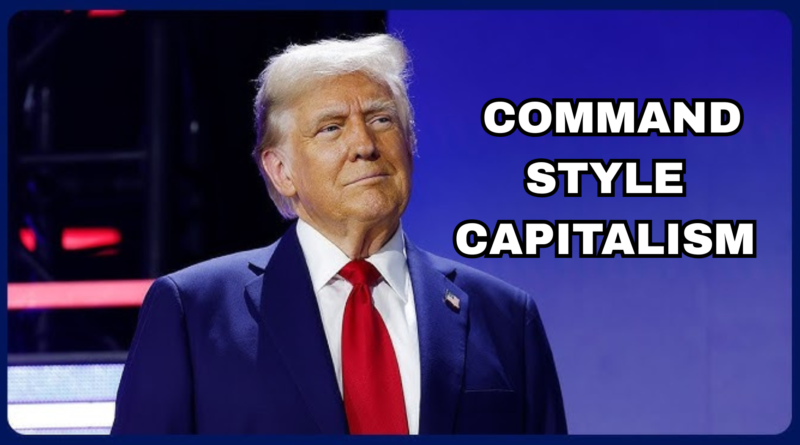TRUMP’S SECOND TERM USHERS IN A NEW ERA OF COMMAND-STYLE CAPITALISM
In a move that has rattled economists, corporate leaders, and international observers, the United States under President Donald Trump’s second term is showing signs of pivoting toward what analysts describe as “command capitalism.” The concept refers to a hybrid economic model in which a government retains the framework of a capitalist market economy but increasingly exercises direct control over private-sector decisions.
The clearest example so far comes from an unprecedented directive aimed at two of America’s most influential semiconductor giants Nvidia and Advanced Micro Devices (AMD). According to reports, the administration has mandated that the companies surrender 15% of revenue from specific China-bound product sales directly to the U.S. government. While the policy is framed as a strategic measure to safeguard national security and ensure that critical technologies do not empower rival nations, it also marks a substantial departure from the hands-off regulatory stance traditionally associated with American capitalism.
From Free Markets to State Steering
For decades, U.S. economic policy has been guided by the principle that market forces, rather than government edicts, should determine corporate conduct. Regulatory interventions have generally been aimed at maintaining competition, ensuring consumer safety, or curbing monopolistic practices not at directly claiming a portion of targeted foreign sales. The new policy represents a more interventionist posture, signaling that Washington is prepared to leverage state authority not merely to regulate, but to actively redirect corporate profits toward strategic national objectives.
Some analysts have likened this to elements of state capitalism seen in countries like China, where the government routinely exerts influence over corporate decision-making in the name of national strategy. Others, however, caution against conflating the two systems entirely, noting that the U.S. still maintains competitive private markets, an independent judiciary, and a relatively transparent regulatory environment. Still, the resemblance in tactics is difficult to ignore.
Geopolitical and Economic Motivations
The administration’s decision appears to be driven by two overlapping imperatives: geopolitical containment and economic rebalancing. On the geopolitical front, Washington has long expressed concern over China’s rapid advancements in AI, quantum computing, and semiconductor manufacturing fields where U.S. companies currently hold a lead. By redirecting a portion of corporate earnings from sales to China into government-controlled funds, the White House aims to both limit Chinese access to cutting-edge chips and bolster domestic R&D budgets.
Economically, the move may also be part of a broader strategy to repatriate wealth generated by American innovation, especially when such wealth risks indirectly enhancing the capabilities of a strategic rival. By tying revenue streams to national priorities, the administration is essentially creating a mechanism for technology reinvestment that bypasses the usual voluntary or market-driven channels.
Industry Response
Corporate reaction has been cautious but concerned. Nvidia and AMD have not issued outright defiance but have hinted that the new policy could disrupt established supply chains, reduce competitiveness in global markets, and invite retaliatory measures from foreign governments. Industry trade groups have warned that such intervention could erode investor confidence and blur the line between public and private enterprise in ways that might discourage innovation.
Still, there are voices within the tech sector that view the shift as inevitable. In a world where technological supremacy increasingly dictates geopolitical power, some executives believe closer alignment with national objectives could secure long-term advantages provided the government offers clear policy stability and compensatory incentives.
International Implications
Globally, the directive sends a strong signal that the U.S. is willing to use its corporate champions as instruments of state policy. For allies, this may encourage closer tech-sector collaboration under U.S. leadership. For rivals, it could trigger countermeasures, such as stricter market access rules or the acceleration of domestic semiconductor programs to reduce reliance on U.S. technology.
The risk is that this approach could fragment global tech markets into competing geopolitical blocs, each with its own supply chains, standards, and governance rules. That outcome could lead to higher costs, slower innovation, and more volatile markets.
The Road Ahead
Whether this policy becomes a defining feature of Trump’s second term or remains a targeted measure will depend on its effectiveness and political reception. If the administration sees tangible benefits such as accelerated domestic tech investment, diminished Chinese tech capabilities, or stronger national security similar interventions could expand into other industries like rare earths, aerospace, and biotechnology.
For now, “command capitalism” in the U.S. remains an emerging experiment: a test of whether a traditionally free-market nation can adopt elements of state-directed strategy without undermining its own economic dynamism. The outcome will not only shape America’s technological trajectory but could also redefine the boundaries of capitalism in the 21st century.




